What Is LED Binning? A Simple Guide
Table of Contents
During the manufacturing of LEDs, inconsistencies are inevitable owing to the complexities of the production process. Each LED within a batch varies in its specific properties. To manage these disparities and promote uniformity, LEDs displaying similar traits are assembled in what is referred to as bins. This process is particularly crucial for white light spectrum LEDs.
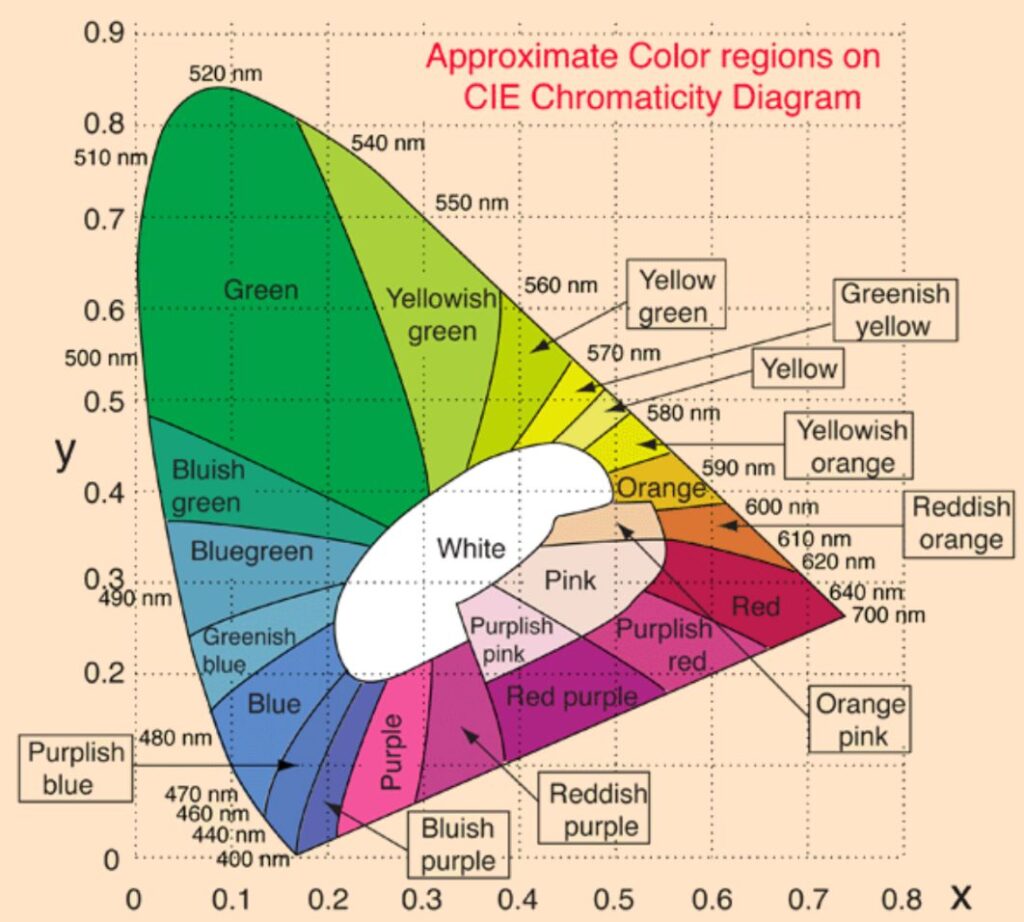
LED binning is used to maintain consistency and classify LED lighting products. It involves the assessment of individual LED chips based on their luminosity, temperature, and other attributes, sorting them into cohorts of similar characteristics.
In this piece, I will delineate the practice of LED binning and provide insights into its various forms. You will understand how this process influences the performance and efficacy of LED lights. So, let’s delve into it-
Explaining LED Binning
LED binning refers to the classification and arrangement of LEDs depending on their distinct characteristics, like brightness and color. This practice guarantees that every LED in a lot complies with specific standards, making them suitable for defined applications.
LED binning assists both manufacturers and consumers in ensuring that the received LEDs meet their respective needs. Additionally, it facilitates the enhancement of production effectiveness and overall quality.
Why are LED binning ranges important for consumers?
The answer is simple: binning systems manage different variations in LED performance during mass production and ensure specific LED lighting standards. Most manufacturers sort their production in:
- Luminosity (Lumen)
- Color temperature (Kelvin)
- Voltage (Volts)
- Color location
Advantages of LED Binning
Maintaining high-quality LED lighting is intrinsically linked with LED binning, offering several advantages such as:
- Enhanced Color Uniformity: The binning of LEDs enables manufacturers to categorize LEDs based on color and brightness. This ensures the homogeneity of LEDs within a single bin, contributing to a more consistent end product.
- Heightened Efficiency: LEDs are allocated into bins according to their performance. For instance, every chip is evaluated to guarantee equal power or brightness during the production of LED strips. If the chips vary in efficiency, the outcome will be subpar. All components are inspected during the LED binning process to uphold quality, resulting in a greater overall efficiency of the finished product.
- Superior Quality Management: LED binning involves testing all fixture features and discarding non-standard components. This allows manufacturers to detect and rectify production-related problems and bolsters the quality of the end product.
LED Binning Categories
LEDs are categorized based on several criteria. There are four main types of LED binning, determined by these variables.
Color Binning
Categorizing Colors in LEDs Color categorization, or “color binning,” involves arranging LEDs according to their color traits. This procedure guarantees that each LED in a group displays the same color intensity and brightness. This can be achieved via high-tech measurement tools or through visual analysis. Furthermore, color binning ensures a uniform lighting performance.
1. The Role of Color Binning
Color binning guarantees LEDs within a product exhibit the same correlated color temperature (CCT). In addition, it offers a precise color rendering index (CRI), which ensures the consistency of the LED light across all units. This process also accurately portrays the colors of objects.
2. Guidelines for Color Binning
The basis for LED color binning is the CIE 1931 Chromaticity Diagram from the International Commission on Illumination. This diagram comprises a set of quadrilaterals that illustrate variations in light spectrums.
According to the CIE standard, LED color temperatures are divided into four categories. These include;
| Type Of Color | Colour Temperature (CCT) |
| Warm | 2700K to 3500K |
| Neutral | 3500K to 5000K |
| Cool | 5000K to 7000K |
| Ultra-cool | 7000K to 10000K |
The Color Rendering Index (CRI) and the Color Quality Scale (CQS) serve as additional standards for categorizing LED colors, known as binning. The CRI assesses a light source’s accuracy in rendering colors compared to natural sunlight. Concurrently, the CQS determines the accuracy of a light source in highlighting subtle color variations. A high-quality LED should boast a CRI of no less than 80 and a CQS not below 70.
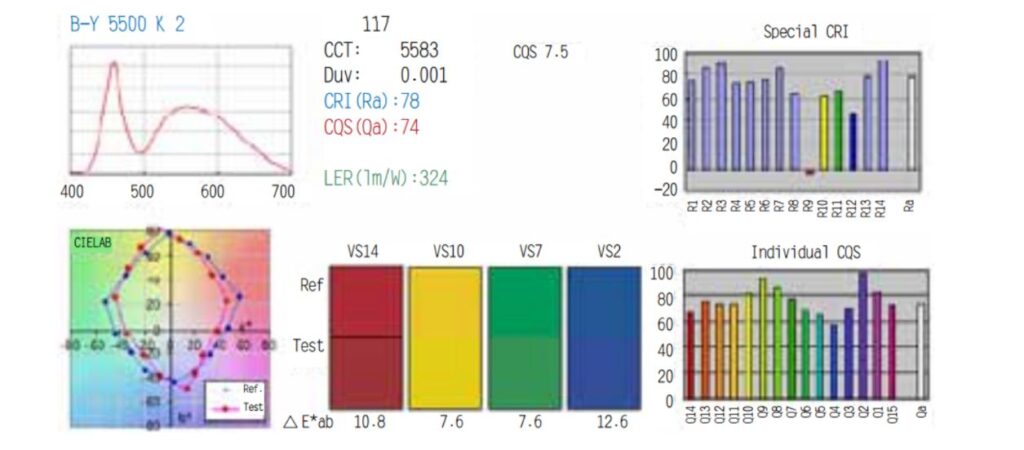
Techniques to Ensure Uniform LED Color Binning
There exist several techniques that can help to maintain consistency in LED color binning.
- Spectrophotometry: This technique involves using a spectrophotometer to measure the spectral characteristics of each LED. The data gathered is then used to categorize the LEDs into separate bins based on their color and luminosity characteristics.
- Colorimeter: A colorimeter is an instrument that measures the color of an LED by analyzing the emitted light. This data is then used to sort the LEDs into different bins, primarily based on their color traits.
- Visual Inspection: This technique manually inspects each LED to identify its color and luminosity attributes. Although this method may be less accurate, it offers a fast and simple way to categorize LEDs into different bins.
- Automated Binning: This process uses machine vision and robotics to sort LEDs into different bins. While it’s a quick and efficient method, it requires high precision and accuracy to ensure uniform results.
Why is LED Binning Range Significant for Color Consistency?
LEDs are classified according to their color temperature through individual measurements and then distributed into predetermined bin ranges. The breadth of a bin range determines the amount of expected variation – wider ranges imply more variation and vice versa. If a producer opts for a broad bin range, it usually translates to a lower cost for their LEDs, leading to a more affordable final product. However, this cost-saving measure may not always be a boon, as it can adversely impact the product’s quality and consistency.
The subsequent illustration demonstrates why the perceived visual experience might differ if the chromaticity coordinates X and Y are distantly positioned, even with the same color temperature. A closer proximity to the Planckian locus in the chromaticity chart indicates a more natural, authentic feel of the light.
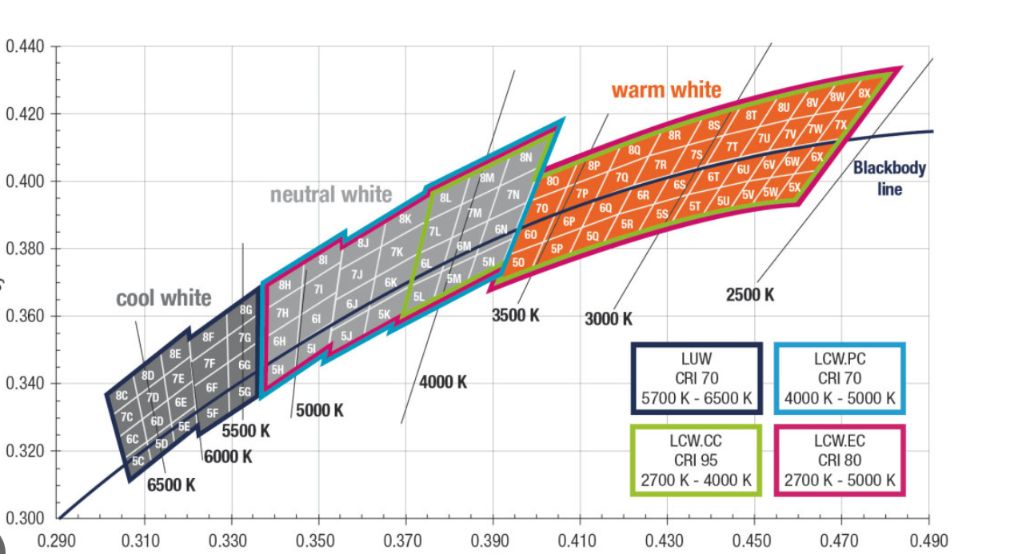
Luminous Flux Binning
Luminous Flux Binning sorts LEDs into distinct groups depending on their light emission. This process involves measuring the light output of each LED, followed by their arrangement into different categories based on their brightness level.
Significance of Luminous Flux Binning
The key principle behind luminous flux binning is categorizing LEDs according to their brightness or light output. The process ensures uniformity in brightness across all fixtures within a batch, guaranteeing consistent lighting. Further, the method helps to prevent the overuse of high-powered LEDs beyond the requirements. By sorting the LEDs based on their brightness and efficiency, it helps to cut costs and boost profitability.
Benchmarks for Luminous Flux Binning
The measurement of luminous flux provides insights into the efficiency and performance of LEDs. Manufacturers establish standards for permissible luminous flux levels for each batch of LEDs. These standards, though varying from manufacturer to manufacturer, typically include categories like “A,” “B-grade,” and “C.” “A” represents the highest quality, while “C” symbolizes the lowest. For instance, an A-grade LED is expected to exhibit a light output equal to or exceeding 90 lumens per watt (lm/W). Conversely, a C-grade LED will likely have less than 70 lm/W.
Techniques for Achieving Uniform Luminous Flux Binning
Several strategies can be implemented to ensure uniform luminous flux binning:
- Statistical Binning: This method, which involves measuring the luminous flux of a large batch of LEDs and dividing them into groups based on flux levels, is highly accurate and commonly used in the industry.
- Spectrophotometer Binning: This technique employs a spectrophotometer to measure each LED’s flux. Though not as precise as statistical binning, it’s still widely applied.
- Visual Binning: This method relies on visually inspecting the LEDs’ brightness. Despite being the least accurate, it finds use in certain applications.
- Binning by Correlation: This technique blends statistical binning with spectrophotometer binning. The correlation between the two methods ensures consistency in binning.
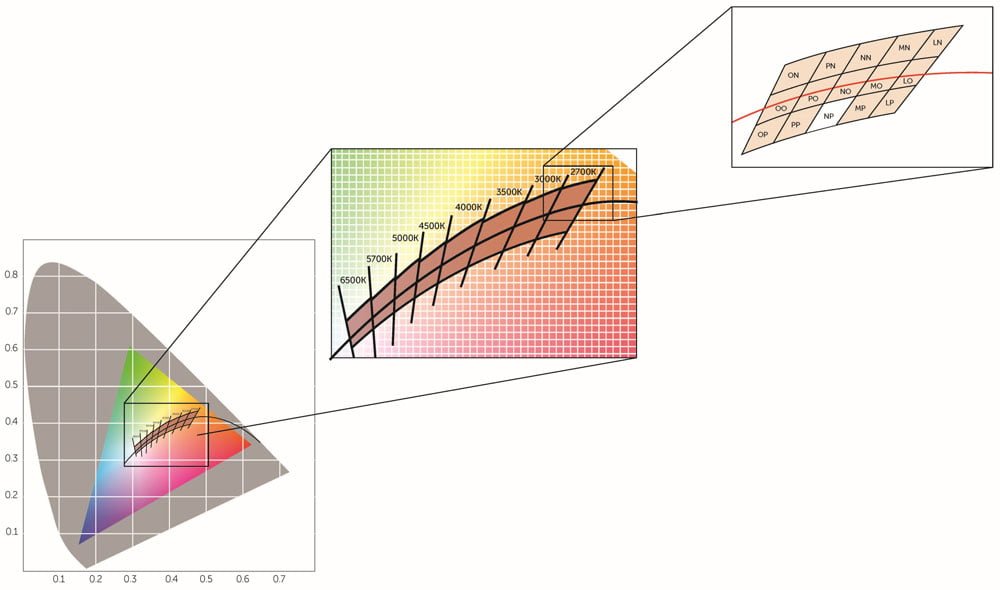
Voltage Binning
LED components are categorized according to their voltage levels through a process known as voltage binning. This ensures their safe application within a common circuit without failure. The quality and performance of an LED component are generally improved with increased voltage.
The Significance of Voltage Binning
The process of voltage binning assesses the safety of LEDs for use. It additionally guarantees that the LED meets the required performance criteria. This process involves the arrangement of LEDs into separate “bins” based on their forward voltage. Hence, it becomes possible to recognize LEDs with a forward voltage that’s either higher or lower than anticipated. This also aids in isolating light fixtures that fail to meet the established standards. Consequently, it minimizes errors and enhances product quality.
Criteria for Voltage Binning
LED bins are typically divided into four types based on forward voltage: high-voltage, low-voltage, standard-voltage, and ultra-low-voltage.
| Forward Voltage Standard | Range |
| High-Voltage | 4.0 – 4.2 V |
| Standard-voltage | 3.3 – 3.6 V |
| Low-voltage | 2.7 – 3.2 V |
| Ultra-low-voltage | 2.7 V |
Achieving Consistent Voltage Binning: Various Approaches
- Multi-Criteria Sorting: This approach categorizes LEDs according to multiple specifications like voltage, current, and luminous flux. This strategy guarantees the uniformity of voltage among LEDs in each bin. Furthermore, the consistency in other features promotes compatibility in voltage binning.
- Application of Reverse Bias: In this approach, a reverse bias voltage is applied to the LED, and the subsequent current flowing through it is measured. LEDs showcasing similar characteristics under reverse bias current are grouped in one bin, promoting consistent voltage binning.
- Temperature-Specific Binning: This process groups LEDs based on their voltage characteristics under distinct temperature conditions. This classification method helps maintain voltage binning uniformity across various temperature ranges.
- Machine Learning-Driven Binning: Utilizing machine learning algorithms, this approach classifies LEDs into bins according to their voltage characteristics. Not only does this method assure uniform voltage binning, but it also identifies minor voltage deviations that other methods could overlook.
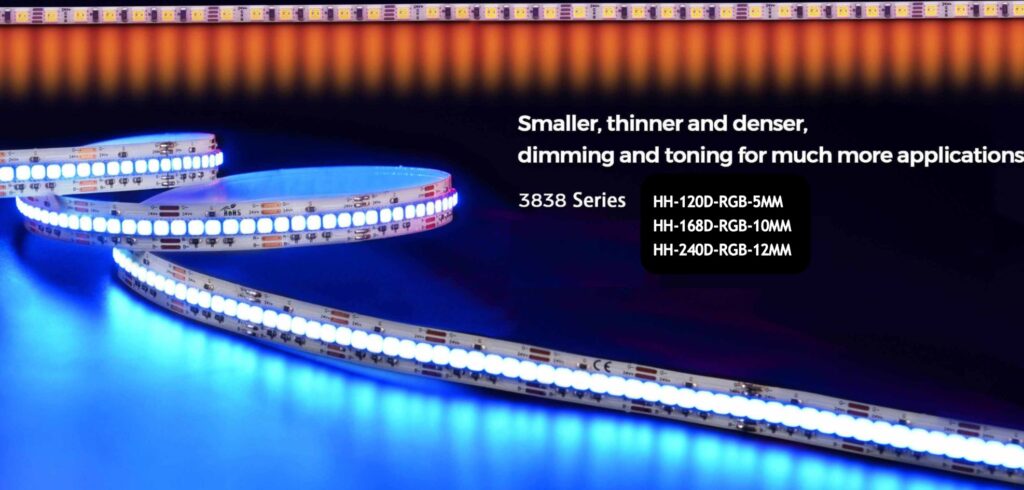
Temperature Binning
Thermal classification, or temperature binning, involves categorizing LED chips according to their optimal operating temperature. While traditionally, LEDs are binned at a standard temperature of 25°C, there has been a shift towards a newer technique called hot binning. In this method, the binning process occurs at a much higher temperature, typically 85°C, surpassing the conventional 25°C standard. This technique enhances the color consistency and chromatic selection of the LEDs. However, the exact hot binning temperature fluctuates depending on the operational temperature of the LED fixture.
The Significance of Temperature Binning
The functionality of an LED may exhibit variation under different operational temperatures. Certain LEDs are expected to endure extreme cold environments, while others must perform efficiently at elevated temperatures. This makes temperature binning critical to ensure that LED bins can function effectively in the intended environment. Consequently, hot binning emerges as a commendable method to augment the temperature resilience of LEDs. This technique mandates using a higher binning temperature for LEDs to guarantee superior performance under challenging conditions.
Guidelines for Temperature Binning
In the realm of LED binning, the operating temperature is an influential determinant that can impact the life expectancy of the fixture either directly or indirectly. Consequently, the temperature is taken into account during the LED binning process. The following is a chart that delineates the light’s operational temperature under varying circumstances:
| Different Lighting Cases | Operating temperature |
| Outdoor Luminaires | 60° to 65°C |
| Freezer Cases | 20° to 25°C |
| Downlights in Insulated Ceilings/Retrofit bulb | often over 100°C |
In organizing the LED binning procedure, take into account the working temperature. Determine the ideal temperature for testing LED chips to guarantee their peak performance.
Strategies for Maintaining Uniform Temperature Binning
- Calibration of Temperature Sensors: The calibration of temperature sensors is essential. It verifies their accuracy in capturing the correct temperature. Manufacturers can cross-check the sensor’s reading with a known temperature source, like a thermocouple, to fine-tune the output.
- Temperature Monitoring Software: This software facilitates tracking and adjusting temperature readings if needed. It can also produce reports and alerts when temperature readings fall outside the desired range.
- Temperature Compensation Techniques: These techniques are designed to rectify temperature fluctuations caused by shifts in ambient temperature. For instance, a thermistor can evaluate the ambient temperature and adjust the power to the LEDs in response.
- Thermal Management: Effective thermal management can assure uniform temperature binning. Manufacturers can achieve this by utilizing heat sinks or other cooling techniques to dispel the heat produced by the LEDs.

Understanding Macadam Ellipse
The Macadam Ellipse technique is utilized in LED binning to identify the color variations within a set of LEDs. This method visualizes the color coordinates (x, y) of a group of LEDs on the CIE 1931 color space chart. Doing so allows for measuring the color consistency among LEDs in a batch. Furthermore, it assesses the distance between each LED’s color coordinates, pinpointing the ellipse’s center. A smaller ellipse signifies a more uniform color within the LED group. This technique is critical in manufacturing LED lighting products, ensuring color uniformity and quality.
The Workflow of LED Binning
LED binning follows a series of key steps, outlined as follows:
Step 1: Organizing LEDs Based on Voltage and Brightness
Create a classification system based on the required voltage and brightness levels. For example, this could range from 1V to 5V for voltage and 0 lumens to 500 for brightness. Each LED should be tested using a multimeter or similar device to measure the voltage and luminosity. The LEDs are then categorized into their appropriate bins.
Step 2: Segmenting the Semiconductor into Die
In the next step, cut the semiconductor using a diamond-tipped saw. Then, sort the die based on color and brightness into appropriate bins. An automated system usually conducts this sorting, which assesses the light output of each die and groups it according to predefined standards.
Step 3: Establishing Wire Bonds and Electrical Connections
Wire bonds ensure a secure electrical connection by tightly wrapping the metal strand around cables. After creating the wire bonds, attach the LED components to their power source via solder or crimp connectors. At this stage, the LEDs are ready for sorting.
Step 4: Binning the LEDs
With proper wire bonds in place, categorize the LEDs based on certain attributes like size, color, voltage, etc. Use a lux meter to measure the LEDs’ light output, verifying if the brightness level matches the required specifications. A spectrometer is then employed to evaluate color accuracy and consistency across the batch. Also, verify the chip size and its voltage. Although automated machinery is typically used for these tasks, manual inspection is also possible but less reliable.
Step 5: Quality Control for LEDs
Following LED binning, conduct a quality assurance check. Here, the quality control team inspects for possible defects, assesses durability, and conducts other tests to confirm that each batch complies with the quality standards.
How Do Color Binning and Flux Binning Differ?
Color binning and flux binning represent two distinct methods for categorizing lights, each focusing on different aspects: color and brightness, respectively.
Color binning is designed to organize and categorize lights based on their coloring attributes. It might entail considering the range of light wavelengths to which they are most sensitive. This procedure usually involves measuring the device’s spectral response and sorting them into separate “bins” according to these properties.
Conversely, flux binning is a method for grouping LEDs according to their lumen ratings. LEDs are categorized by their level of brightness in this process. The rule of thumb is: the higher the lumen rating, the brighter the light emitted.
In conclusion, while color binning focuses on the color characteristics of light, flux binning considers the light’s brightness for sorting LEDs.
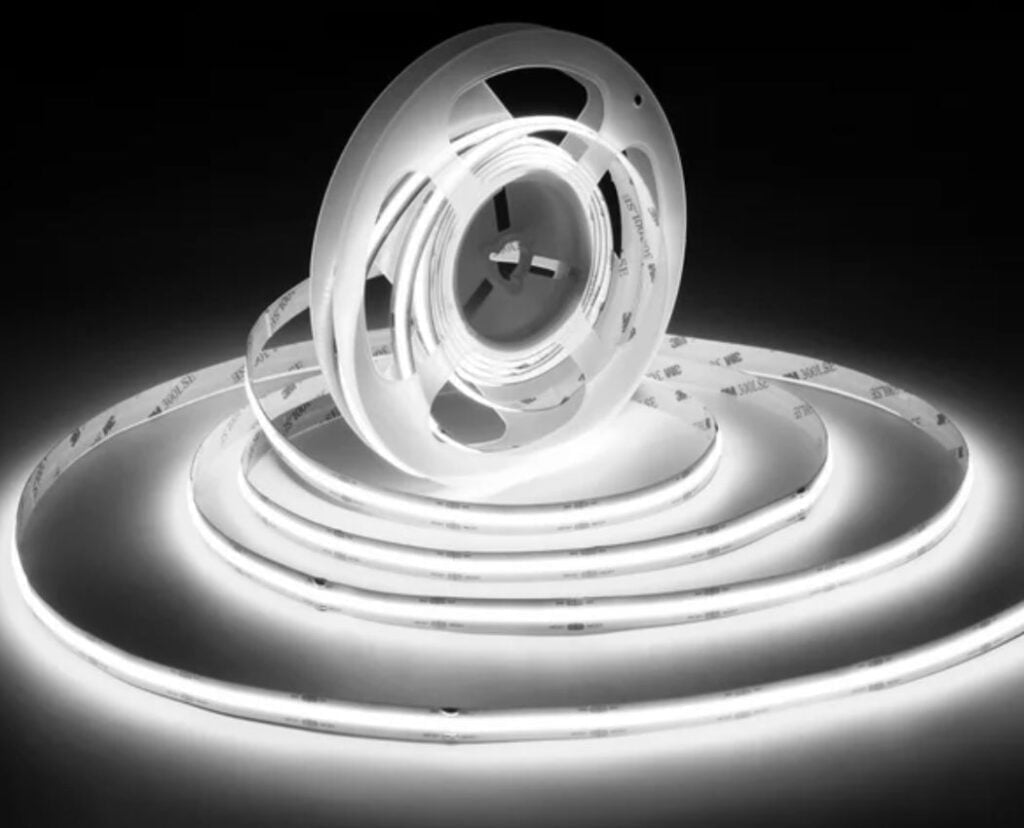
Considerations for LED Binning
Various elements can influence the success of LED binning:
Bin Criteria
Within the process of LED binning, the following classification principles should be taken into account:
- Luminous Flux: This measures the light radiated by the LED in lumens. LEDs are categorized into bins according to their luminous flux, with higher flux levels represented in higher bins.
- Color Temperature: The hue of light the LED emits, quantified in Kelvins. LEDs are sorted into bins based on color temperature (CCT ratings). Higher CCT bins represent cooler (bluer) colors, whereas lower ones indicate warmer (redder) hues.
- Forward Voltage pertains to the voltage needed to operate the LED, measured in volts. LEDs are assigned to bins according to their forward voltage, with higher voltage requirements belonging to higher bins.
Technical Aspects
The following technical factors should be considered in LED binning:
- Measurement Equipment: Precise measuring equipment is crucial for testing and sorting the LEDs according to their performance attributes.
- Binning Algorithm: The algorithm employed to classify and group the LEDs should be consistent and able to be repeated.
- Temperature: This can greatly affect the performance of LEDs. Therefore, measuring and sorting the LEDs at a consistent temperature is crucial.
- Binning Standards: Different use cases may necessitate different binning standards. It’s essential to comprehend and comply with the binning standards relevant to a specific application.
- Automation: Systems that automate the binning process can enhance efficiency and minimize human error.
- Traceability: The ability to track the binning process and the characteristics of each sorted LED is crucial.
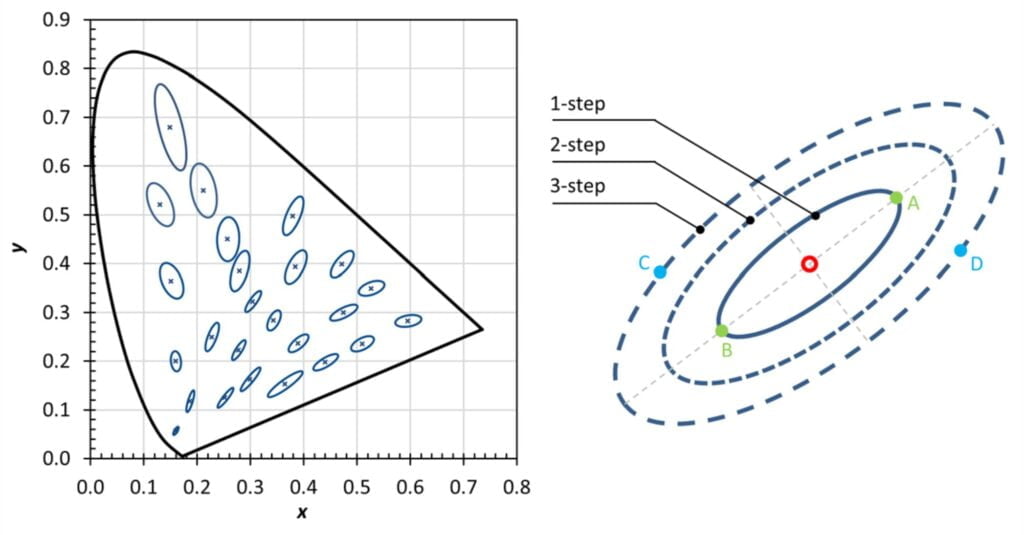
Standards for LED Binning in the Industry
The standards for LED binning in the industry can differ based on their uses. Here are some common standards:
- ANSI C78.377-2017: Crafted by the American National Standards Institute (ANSI), these standards apply to LED lamps and luminaires, setting out the color and chromatic specifications for general lighting services.
- IES LM-80-08: Designed by the Illuminating Engineering Society (IES), these guidelines help measure and report the lumen maintenance of LED light sources.
- JEDEC JS709A: Developed by the Joint Electron Device Engineering Council (JEDEC), this standard outlines the binning and sorting requirements for high-brightness LEDs.
- CIE S025/E:2017: Set by the International Commission on Illumination (CIE), this standard gives guidelines for the color coordinates of LED light sources.IEC 60081: A standard for fluorescent lamps, this defines 5-step MacAdam ellipses for six nominal CCTs.
Environmental Regulations for LED Binning
As for environmental regulations in LED binning, they differ by region and application but typically include the following;

- Adherence to RoHS (Restriction of Hazardous Substances) Directive: This directive by the EU prohibits the use of specific hazardous substances in electronic items. Such substances encompass lead, cadmium, and mercury, and their presence needs to be considered during LED binning.
- Energy Efficiency Standards: Various countries have set energy efficiency benchmarks for lighting items, including LED products. These standards may mandate minimum energy efficiency levels or state other products’ maximum power consumption levels.
- Safety Standards: LED products must comply with relevant safety standards, such as UL and CE, to guarantee they are not fire or electrical hazards.

Impacts of Temperature on LED Binning
LEDs’ response to temperature is inversely tied to the forward voltage, VF. An upsurge in temperature reduces the forward voltage, prompting an amplified current flow through the LEDs. Such an extreme current flow may detrimentally influence the fixture’s performance.
Temperature changes also influence the LED binning’s impact on the LED’s luminous flux. The temperature escalation decreases the luminous flux, thus directly lowering the light’s brightness.
Moreover, temperature regulation can influence an LED’s overall lifespan. An increase in an LED’s temperature expedites its deterioration rate, resulting in a shorter lifespan. However, effective temperature management can counteract this effect.
Common Problems Encountered in LED Binning
During the process of LED binning, certain frequent challenges can arise, including:
- Color Discrepancies: Despite maintaining a consistent color trait during the sorting and grouping of LEDs in the binning process, some LEDs might exhibit minor color variations, potentially impacting a lighting system’s appearance.
- Lumen Deterioration: LEDs are sorted according to their luminous flux and brightness during LED binning. Over time, an LED’s brightness might diminish, a phenomenon referred to as lumen depreciation, which could result in irregular lighting and hamper the system’s performance.
- Misclassification: LEDs might not be accurately sorted or grouped during the binning process, leading to inconsistencies in performance and color, thus causing potential issues with the lighting system.
- Expenses: The LED binning process can be expensive, requiring specialized machinery and expert workers, which can consequently affect the total cost of a lighting system.
Strategies to Streamline Your LED Binning Procedure
- Establish precise binning parameters for your LEDs: Determine the criteria for binning, such as color temperature, luminous flux, and forward voltage. This provides a uniform standard for assessing all LEDs.
- Implement a uniform testing methodology: Maintain the same testing protocols throughout the binning procedure. This might involve utilizing the same tools and measurement methods and maintaining consistent conditions for each LED test.
- Employ automated binning software: Utilizing automated binning software can simplify operations and minimize potential human errors. Such software can automatically classify LEDs into distinct bins.
- Maintain comprehensive documentation: Preserving detailed records can aid in identifying and resolving potential problems and serve as a resource for future reference. This could encompass information about the utilized testing equipment, the binning parameters, and each test’s outcomes.
- Routinely assess and modify your binning process: By regularly reviewing and updating your binning process, you can ensure consistently optimal results and rectify previous issues.
Conclusion
In summary, LED binning essentially serves as a categorization method for LEDs, sorting them based on their optical and electrical attributes. This crucial procedure guarantees that LEDs with similar specifications are packaged together, enhancing LED-based commodities’ overall performance and individuality. It’s undeniable that LED binning will persist in its paramount role in the progression and refinement of LED technology.
MyLikeLed, known for manufacturing superior LED strips and LED neon flex, ensures every product undergoes rigorous testing in advanced laboratories for maximum quality. Additionally, we allow our customers to customize their LED strips and neon flex. Contact MyLikeLedtoday for top-notch LED strip and LED neon flex solutions!
FAQs
LEDs are categorized based on factors such as luminous flux (brightness), color temperature, and forward voltage. Each batch of LEDs is tested and grouped into different bins that share similar properties, allowing manufacturers to offer a consistent product range.
Yes, LEDs with higher brightness or better color consistency (from higher bins) often come at a premium price. Lower-binned LEDs with slightly reduced performance may be sold at a lower cost, making binning a factor in determining the price of LED lighting products.
Yes, LED binning can affect the appearance of lighting, especially when different binned LEDs are used together. If LEDs from different bins are mixed, the lighting might show visible color or brightness inconsistencies. High-quality products ensure LEDs from the same bin are used together for uniform lighting.
Manufacturers test the performance of each LED, measuring parameters like color accuracy, brightness, and voltage. Based on the results, the LEDs are grouped into specific bins to ensure they meet the desired standards. The binning process helps ensure that consumers receive LEDs with consistent and reliable performance.
Yes, LEDs from higher bins with better brightness and color accuracy may also have longer lifespans due to their better performance characteristics. Lower-binned LEDs might experience reduced efficiency or shorter lifespans, especially if they are used beyond their rated limits.

Hi, I’m Xylia Xiong, a sales professional with 14 years of experience in the LED strip light industry. I specialize in providing tailored solutions, leveraging my expertise in LED products and the latest industry trends. Known for effective communication and problem-solving, I’m dedicated to helping lighting manufacturers, importers, and distributors achieve their goals.
Let’s work together to create customized solutions that exceed expectations.
Related Posts

The Best LED Strip Lights You Can Buy Right Now

Comparing WS2811 Vs WS2812B: Key Differences


